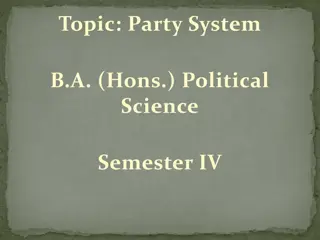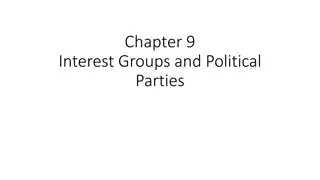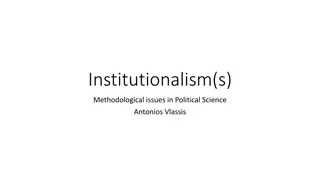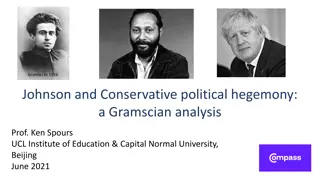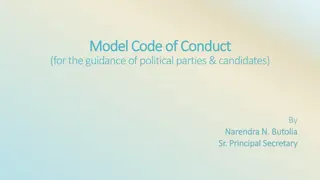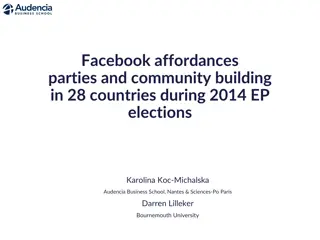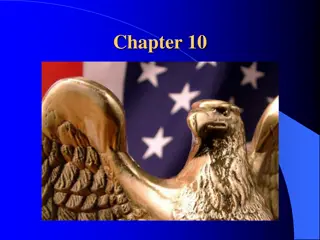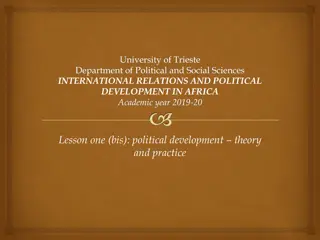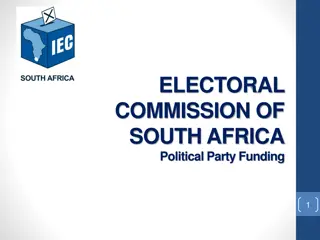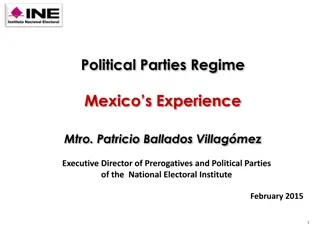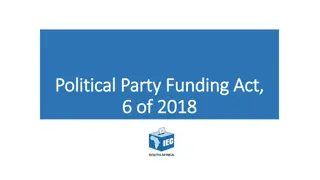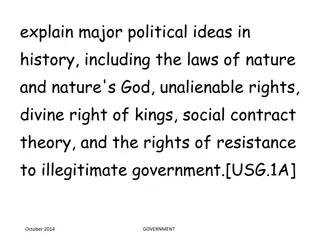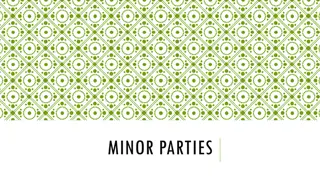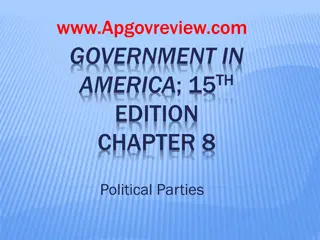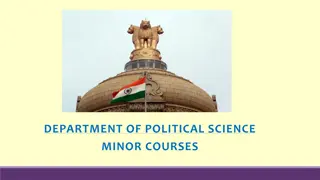Understanding Political Parties: Roles and Functions
Political parties play a crucial role in the democratic process by serving as a linkage institution between citizens and the government. They function to pick candidates, run campaigns, give cues to voters, articulate policies, and coordinate policymaking. Parties are composed of the electorate, organization, and government, with party identification and ticket-splitting shaping electoral outcomes. Party organizations, from local grassroots to state levels, employ strategies such as closed, open, and blanket primaries to engage voters and influence election results.
Download Presentation

Please find below an Image/Link to download the presentation.
The content on the website is provided AS IS for your information and personal use only. It may not be sold, licensed, or shared on other websites without obtaining consent from the author. Download presentation by click this link. If you encounter any issues during the download, it is possible that the publisher has removed the file from their server.
E N D
Presentation Transcript
The Meaning of Party Political Party: A team of men [and women] seeking to control the governing apparatus by gaining office in a duly constituted election. Parties can be thought of in three parts: Party in the electorate Party as an organization Party in government
The Meaning of Party Tasks of the Parties Linkage Institution: The channels through which people s concerns become political issues on the government s policy agenda. Parties Pick Candidates Parties Run Campaigns Parties Give Cues to Voters Parties Articulate Policies Parties Coordinate Policymaking
The Meaning of Party Parties, Voters, and Policy: The Downs Model Rational-choice theory: Assumes that individuals act in their own best interest, weighing the costs & benefits. Figure 8.1
The Party in the Electorate Party identification is a citizen s self-proclaimed preference for one party or the other. Ticket-splitting: Voting for candidates of different parties. Year 1964 1976 1988 2000 Dem 52.2 40.2 35.7 34.8 Ind 23 36.8 36.3 41.0 Rep 24.8 23.0 28.0 24.2
The Party Organizations: From the Grass Roots to Washington These are the people that work for the party. Local Parties Party Machines: A type of political party organization that relies heavily on material inducements to win votes and to govern. Patronage: A job, promotion or contract given for political reasons rather than merit. Used by party machines. Now urban party organizations are generally weak. County organizations have partially filled the void.
The Party Organizations: From the Grass Roots to Washington The 50 State Party Systems Closed primaries: voters must be registered with their party in advance and can only vote for that party Open primaries: voters decide on election day which party to participate in, and then only that party Blanket primaries: voters get a list of all candidates and can vote for one name for each office, regardless of party label State party organizations are on an upswing in terms of headquarters and budgets.
The Party Organizations: From the Grass Roots to Washington The National Party Organizations National Convention: The meeting of party delegates every four years to choose a presidential ticket and the party s platform. National Committee: One of the institutions that keeps the party operating between conventions. National Chairperson: Responsible for day-to- day activities of the party.
The Party in Government: Promises and Policy These are the party members actually elected to government. Candidates are less dependent on parties to get elected, but they still need help. Coalition: A group of individuals with a common interest upon which every political party depends. Parties & politicians generally do what they say they will do.
Party Eras in American History Party Eras Historical periods in which a majority of votes cling to the party in power. Critical Election An electoral earthquake where new issues and new coalitions emerge. Party Realignment The displacement of the majority party by the minority party, usually during a critical election.
Party Eras in American History 1796-1824: The First Party System Madison warned of factions First party were the Federalists 1828-1856: Jackson and the Democrats Versus the Whigs Modern party founded by Jackson Whigs formed mainly in opposition to Democrats
Party Eras in American History 1860-1928: The Two Republican Eras Republicans rose as the antislavery party 1896 election revolved around the gold standard 1932-1964: The New Deal Coalition Forged by the Democrats - relied upon urban working class, ethnic groups, Catholics and Jews, the poor, Southerners
Party Eras in American History 1968-Present: The Era of Divided Party Government Party dealignment- disengagement of people from parties Party neutrality- people are indifferent towards the two parties
Party Eras in American History Partisan Control of State Governments: 2003 (Figure 8.4)
Third Parties: Their Impact on American Politics Political parties other than Democrat or Republican Rarely win elections But, they bring new groups and ideas into politics Two-party system discourages extreme views
Third Parties: Their Impact on American Politics Winner-take-all system: Legislative seats awarded only to first place finishers. Proportional Representation: Legislative seats awarded based on votes received by the party- more votes, more seats Coalition Government: Two or more parties join to run government
Understanding Political Parties Democracy and Responsible Party Government 1. Parties have distinct comprehensive programs. 2. Candidates are committed to the program. 3. Majority party must carry out its program. 4. Majority party must accept responsibility.
Understanding Political Parties Individualism and Gridlock Easier to pass the buck than bite the bullet Lack of uniformity even within parties American Political Parties and the Scope of Government Lack of uniformity keeps government small But, it also makes cutting government programs harder to do
Understanding Political Parties Is the Party Over? No longer the chief source of information for voters But, state and national party organizations are getting stronger Majority of people still identify with a party, but still split their tickets Parties will continue to be around


